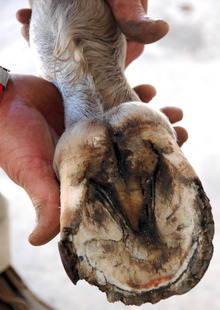If a horse suffers a puncture wound is to the hoof, it may be difficult to determine which of the vital structures of the foot have been injured and contaminated with microorganisms.

An injured horse hoof
The deeper the penetration of a nail into the horse's hoof, the more likely it is that the pedal bone, the navicular bursa and other finely-tuned parts of the foot may be affected.
© 2012 by April Raine
The deeper the penetration is, the more likely it is that the pedal bone, the navicular bursa, the coffin joint, the flexor tendon, and other finely-tuned parts of the foot may be affected.
Unless the penetrating nail or object is removed and proper treatment given, serious complications may develop, requiring surgery and long-term antibiotic treatments.
A puncture wound to the hoof is a true emergency, and a veterinarian should be called immediately. The veterinarian may want to X-ray the foot before the penetrating object is removed. The horse should be kept calm, and not allowed to walk with the nail in place. Do not remove the nail if your veterinarian can come promptly.
Radiographs taken with the nail in place are helpful to determine the path of the nail, and if the nail entered the bone or any synovial structures such as the coffin joint, navicular bursa, or digital tendon sheath.
If any of these structures have been penetrated, surgical treatment and aggressive medical therapy may be necessary to treat infection, and prevent potential severe and life-threatening lameness that can result in founder of the opposite foot or even necessitate euthanasia.
After the puncture wound is treated, the horse should be kept in a clean stall and the veterinarian's directions followed regarding further monitoring and treatment, as well as how soon the horse returns to normal activities.
Read more about Puncture Wounds
